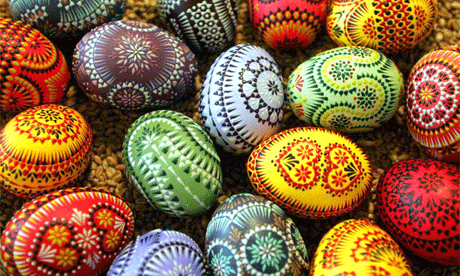Did you know that Easter has a long
history steeped in a myriad of traditions that stem from pagan and Christian
beliefs? Here is a brief illumination into a few of the historical traditions
of Easter.
Spring,
a Time of Celebrations
Since the beginning of time, humans have enjoyed the
arrival of spring after a long cold winter. The Earth was seen as coming to life
once again or being reborn at this time. The vernal or spring equinox, “the
24-hour period when day and night are equal,” [1]
has long been celebrated by many groups of people throughout history as a
special event and takes place between March 21 and April 25 each year.
The pagans celebrated the spring equinox with a
feast to honor the goddess of spring. Known by the name of Oestre or Eastre by
the Anglo-Saxons and Ostara by the Germanic pagans, the goddess of spring
received her name from the word, dawn, or light that rises from the east. The “Teutonic
moon goddess Ostara”[2]
was a goddess of love and fertility that “had a passion for new life.”[3]
Today, the name that we associate with the holiday of Easter is originates from
this goddess.
Another springtime celebration that occurs around
this time of year is the Jewish holiday of Passover. The eight day celebration and
feast starts “on the 15th day of the Hebrew month of Nisan,” and commemorates
the House of Israel’s escape from Egyptian servitude and bondage.[4]
The Christian holiday of Easter celebrates the death and resurrection of Jesus
Christ, which occurred just after the Jewish Passover and the two have been
entwined ever since. One hundred years after the resurrection of Christ, the
Catholic Church was divided on the dates when to celebrate Easter, with one
group wanting to following the Passover tradition for a weekday observance,
while the other group favored celebrating Easter on Sunday.[5]
The problem was solved in 325 A.D., when Emperor Constantine had an assembly at
the Council of Nicaea decide the official date, which they concluded would be “on
the first Sunday after the first full moon of spring.”[6]
The
Easter Bunny
The rabbit was seen as a sacred animal by the pagans,
especially considering the animal’s ability to create new life rapidly; and the
goddess of spring Ostara was often worshiped through a representation “of a
hare.”[7]
However, the Easter Bunny as we now know him hops into this holiday tradition
from sixteenth century Germany. German children came to believe that the Easter
bunny, much like the platypus indigenous to Australia, laid eggs. Before the Easter
bunny brought baskets full of candy and toys for children or hid their
colorfully decorated eggs, he laid eggs in nests built for him by the children.[8]
The Oschter Haws, as he was called,
only laid his eggs for the good boys and girls. Like a fury varmint version of
St. Nicolas, the Easter Bunny was also known to have the power of flight. It is
possible that the legend of an egg laying and flying Easter Bunny originated
from the old pagan belief that Ostara had once saved a bird whose wings had
been frozen by changing it into a rabbit.[9]
As German families immigrated to the New World and settled in Pennsylvania,
they brought with them their Easter traditions and the legend of what would
become our Easter Bunny.
The
Easter Egg
Even before the Oschter
Haws or Easter Rabbit laid his Easter eggs for all good boys and girls, the
egg was seen as a symbol of resurrection or new life throughout ancient
cultures around the world. Both the rabbit and the egg shared a similar symbolism
of virgin birth. Chickens are capable of laying eggs without the aid of a
rooster; and in some pagan cultures, the rabbit were believed to be able to “conceive
without a male, and even give birth without losing its virginity.”[10]
For this reason, the two have been adopted into the Christian observance of
Easter to represent the immaculate conception of the Virgin Mary and resurrection
of Christ.
The tradition of hardboiled eggs date back to the
Medieval Ages and have ties to the Lent. During Lent, eggs were not consumed,
so the eggs were collected, boiled, and given as gifts to friends and family
during the Easter season. The painting of Easter eggs, which were once
multicolored to represent “the sunlight and spring”[11]
by the pagans, started to be painted “bright red to symbolize the blood of
Christ” by Orthodox Christians located in the Middle East and Greece.[12]
[1]
Bethanne Kelly Patrick and John Milliken Thompson, An Uncommon History of Common Things, (Des Moines: National
Geographic, 2009), 54.
[2]
Susan E. Davis and Margo DeMello, Stories
Rabbits Tell: A Natural and Cultural History of a Misunderstood Creature, (New
York: Lantern Books, 2003), 138.
[3]
E.A. Jensen, Manipulating the Last Pure
Godly DNA: The Genetic Search for God’s DNA on Earth, (Victoria: Trafford
Publishing, 2012), 221.
[4]
Patrick and Thompson, An Uncommon History
of Common Things, 53.
[5]
Ibid, 54.
[6]
Davis and DeMello, Stories Rabbits Tell,139.
[7] Ibid,
138.
[8]
Ibid, 140.
[9]
Patrick and Thompson, An Uncommon History
of Common Things, 54.
[10]
Davis and DeMello, Stories Rabbits Tell,
140.
[11]
Gregory K. Moffatt, The Parenting
Journey: From Conception Through the Teen Years, (Westport: Praeger
Publishers, 2004), 282.
[12]
Ellen L. Diggs, On the Road to the Cross:
Meditations and Scriptures for the Lenten and Easter Season, (Bloomington:
CrossBooks, 2011), 67.


















No comments:
Post a Comment